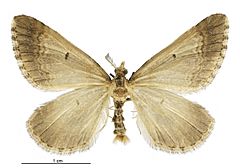Remuremu looper moth facts for kids
Quick facts for kids Asaphodes frivola |
|
|---|---|
 |
|
| Male | |
| Conservation status | |
 Nationally Critical (NZ TCS) |
|
| Scientific classification | |
| Kingdom: | |
| Phylum: | |
| Subphylum: | |
| Class: | |
| Order: | |
| Family: | |
| Genus: |
Asaphodes
|
| Species: |
A. frivola
|
| Binomial name | |
| Asaphodes frivola (Meyrick, 1913)
|
|
| Synonyms | |
|
|
Asaphodes frivola, also known as the remuremu looper moth or Foveaux looper moth, is a special kind of moth found only in New Zealand. What makes it unique is that the female moths cannot fly! They have tiny, twisted wings that don't work. This moth is endemic (meaning it lives nowhere else) and critically endangered. It lives in a very specific type of coastal habitat in just two small places near Invercargill.
Contents
About the Remuremu Looper Moth
The Asaphodes frivola is a small moth. It is a straw-coloured moth with a wingspan of about 30 mm. Only the male moths can fly. Female moths have twisted wings that are too small to fly. Instead, they have long legs and can run very fast.
Some other New Zealand moths also have females that cannot fly. This helps the females carry more eggs. However, it also means they cannot easily move to new areas.
Life Cycle
Adult A. frivola moths appear between mid-March and mid-April. They are active on warm nights. During the day, males are easily disturbed. They will fly short distances before landing again.
Eggs are laid in autumn and hatch after about a month. The young larvae are dull greenish-grey with hints of pink. As they grow, they develop a herringbone pattern on their backs. They can grow up to 20 mm long. Scientists think they likely turn into pupae after nine months, but this part of their life has not been seen yet.
Discovery and Names
This moth was first described by Edward Meyrick in 1913. He named it Xanthorhoe frivola. The first specimen was a single male moth. It was found in 1912 in a swampy forest near Invercargill. Alfred Philpott collected it and sent it to the British Museum.
After this first moth was found in 1912, no one saw the species again for almost 70 years! Then, on March 19, 1981, a scientist named Brian Patrick found them again. He was looking for another moth species near Otatara, a suburb of Invercargill. At Sandy Point, he discovered both male and flightless female moths. They turned out to be A. frivola.
This moth does not have one main common name. It is sometimes called the "little brown moth." It is also known as the Foveaux looper moth, named after nearby Foveaux Strait. Another name is the remuremu looper moth, which comes from the plant it is thought to eat.
Where They Live
The A. frivola moth lives only along a small part of the Southland coast in New Zealand. They live in a very narrow strip of short grassy areas. This strip is usually only 30–50 cm wide and is right next to shell or gravel beaches.
The main plants in this habitat are knobby club rush (Ficinia nodosa) and silver tussock (Poa cita). Scientists first thought the moth's main food plant was a coastal buttercup called Ranunculus glabrifolius. But later studies suggest it is more likely to be a creeping plant called Selliera radicans, also known as remuremu.
Moth Populations
The first moth specimen was likely found at the New River Estuary. This is the same area where the Sandy Point population was found in 1981. In 1984, a second group of moths was found at Tiwai Point near Bluff. In 2011, 10 males and 5 females were collected there.
On April 18, 2013, a third group was found. This was at the Three Sisters Sand Dune. It is on the southern side of the New River Estuary. However, a survey in 2014 could no longer find A. frivola at Sandy Point. It seems they disappeared because of human activity, like off-road vehicles damaging the area. Also, native plants were replaced by weeds.
So, the world's population of this moth now seems to be only at Tiwai Point and Three Sisters. As of 2014, only 34 males and 6 females of this species had ever been found by scientists.
Protecting the Moth
The A. frivola moth is at a very high risk of disappearing forever. It has already vanished from one of the three places it was known to live. Its main population at Tiwai Point lives in an area smaller than 25 square meters. The second population at Three Sisters Sand Dune is probably a similar size.
Both of these small areas are in danger. Threats include more damage from off-road vehicles, roads getting bigger, invasive weeds taking over, and fires. If nothing is done to protect them, scientists predict the A. frivola moth could become extinct within 10 to 30 years.
Because of this danger, the Department of Conservation in New Zealand gave it a threat ranking of "Nationally Endangered" in 2012. This was increased to "Nationally Critical" in 2014. This means it is one of the most endangered species in the country.

